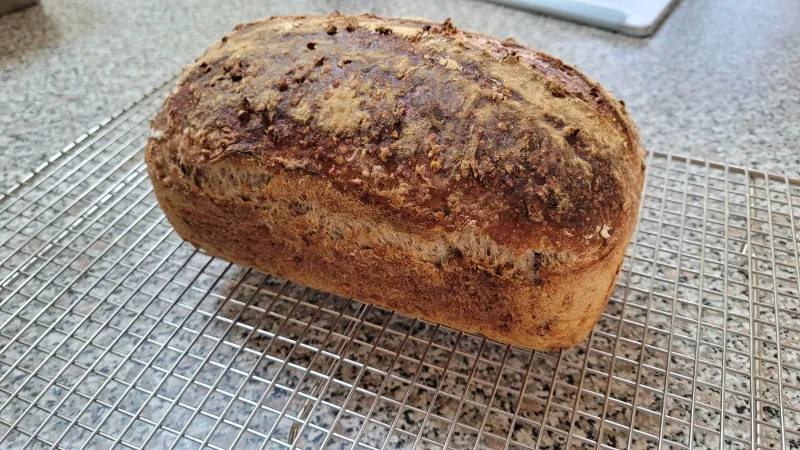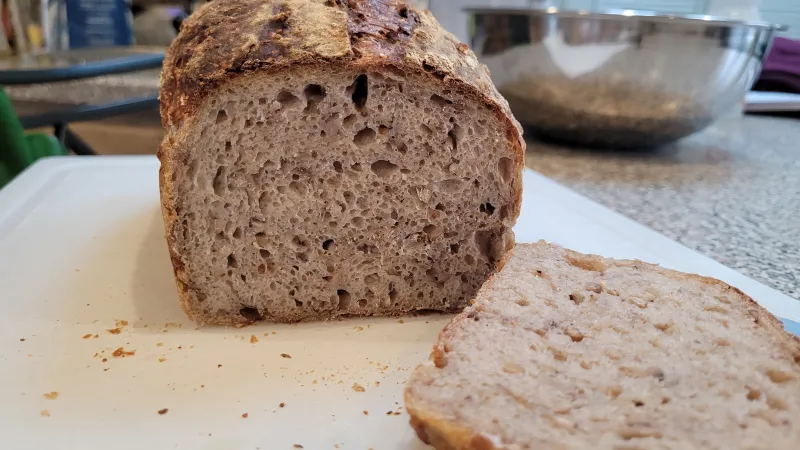Hi everyone - I recently made this bread, which I believe I first read about on this forum:
https://breadtopia.com/toasted-buckwheat-porridge-sourdough-bread/
Wanted to share my experience and see if anyone has any tips. First, I am a pretty experience sourdough baker at this point, but have mostly stuck to traditional country-style loaves, like Tartine, FWSY, etc. For the last year, I've almost exclusively been making the Country Blonde and Field Blend #2 from FWSY, and have it down pretty good. The "craziest" I've gotten is adding cranberries and nuts to my loaves, and sometimes sesame seeds, and I wanted to try something different - so went for this buckwheat porridge loaf.
Overall, I guess it was sort of a success, in that it tasted great and had a wonderful crust - but it was a bit more dense than I would have liked. This was also my first time baking a sourdough in a loaf pan, but I did that more because of some issues I ran into. Here's some points from my bake, and some questions. Curious to hear what people say about these.
- The recipe just called for adding 80g of starter. I wasn't sure if that meant a recently fed starter, a levain or what. So I ended up preparing a levain in the morning, using the same ratios as FWSY Country Blonde (4:4:1:1, white flour:water:ww flour:starter) . I prepped the levain at around 9am, and mixed my dough around 5pm - it seemed pretty active then - but maybe not as much as if I would have added a starter directly in, maybe fed the night before?
- After 2 hours of folding, the dough wasn't as active as I expected. Especially after folding in the soaked buckwheat. Also, the dough became extremely wet after adding the buckwheat - even though I had drained it as thoroughly as I could.
- The recipe said the dough should double - I waited until around 11:30pm (72 deg kitchen) and it didn't seem to change that much. I had to go to bed by then, so I turned it out, did a pre-shape, and let it rest 30 min. The dough was so wet it was almost completely unshapeable. My main question here is, I wonder if this is b/c of the moisture from the buckwheat, or maybe it was actually overproofed by then?
- I did the best I could for shaping, but didn't want to risk having it completely stick to a proofing basket, so I just oiled up a loaf pan and put it in there for the night in the fridge.
- Next morning, took loaf out of fridge. Didn't look any different than the night before. Does this mean anything?
- I baked it up, and ended up with what you see below. I ended up putting the whole loaf pan into my dutch oven to try to get some steam for the first half of the bake - not sure how much this did.
Like I said, it tasted great, and texture was good too - but a bit dense. One aspect I really loved about this bread, was that the buckwheat around the outside got really crunchy when baked, giving it a sort of nutty-crunchy texture which I loved.I want to make this again, not sure what to do differently next time. Any tips would be much appreciated!


Analysis - Excellent!
Tip - Repeat!
Bon Appetit.
Hah! Thanks. Well there's always room for improvement!
I agree fully with Abe. Nothing at all wrong with that BW loaf. A slightly denser crumb is expected with the BW, and what you have there looks great!
The BW can get “slimy” and give your dough that wet feel, especially if you fold it in after developing some gluten. A couple things to try if you really want to get away from that feel…. Add the BW at mixing and increase your mix time a bit until you have good gluten or increase the number of folds after adding the BW to get that extra moisture into the gluten network. But again, what you have looks great! Reminds me that I need to do another BW loaf!
Thanks. In general, if the recipe just says "80g starter", does that usually just mean you add your starter straight in? Versus build a levain with it first? Adding starter directly, vs building a levain seems like it would impact the timings, as I guess the starter would have more activity already than a levain mixed that morning.
I'm thinking next time I will feed my starter the night before and then just use that directly in the dough.
Either should be used at optimal time. You can go down the levain route e.g.
Allow that to mature and use in the dough the next morning. Or feed your starter the night before and use the next morning. For all intense purposes a levain is an off-shoot starter. There are reasons for building a levain but essentially a similar method is applied. A levain should be active!